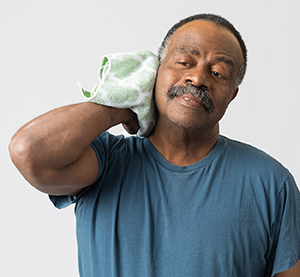Neck Problems: Relieving Your Symptoms
The first goal of treatment is to relieve your symptoms. Your healthcare provider may recommend self-care treatments. These include resting, applying ice and heat, taking medicine, and doing exercises. Your healthcare provider may also recommend that you try physical therapy.

Self-care treatments
Pain can end quickly or last a while. Either way, you’ll want relief as soon as possible. Your healthcare provider can tell you which treatments to do at home to help relieve your pain:
-
Lying down for a short time takes pressure from the head off the neck.
-
Ice and heat can help reduce pain. To bring down swelling, rest an ice pack wrapped in a thin towel on your neck for 10 to 15 minutes. To relax sore muscles, apply a warm, wet towel to the area. Or you can take a warm bath or shower.
-
Over-the-counter medicines such as ibuprofen, naproxen, and aspirin can help reduce pain and swelling. Acetaminophen can help relieve pain. Use these only as directed.
-
Exercises can relax muscles and ease stiffness. To prepare, drape a warm, wet towel around your neck and shoulders for 5 minutes. Remove the towel. Then do any exercises recommended to you by your healthcare provider.
-
Reducing stress may help prevent recurring neck pain. Emotional stress can increase neck tension. It can make your recovery take longer. Activities that may help reduce stress include deep breathing and meditation.
Medical therapies
If self-care treatments aren’t helping relieve neck pain, your healthcare provider may suggest physical therapy.
Physical therapy is done by a specialist trained to treat injuries and musculoskeletal disorders. Your physical therapist (PT) will teach you how to strengthen muscles, improve the spine’s alignment, and help you move properly. Treatment methods used in physical therapy may include:
-
Heat. A special heating pad called a neck pack may be applied to your neck.
-
Exercises. Your PT will teach you exercises to help strengthen your neck and improve its range of motion.
-
Joint mobilization. The PT gently moves your vertebrae to help restore motion in your neck joints and reduce neck pain.
-
Soft tissue mobilization. The PT massages and stretches the muscles in your neck and shoulders.
-
Electrical stimulation. Electrical impulses are sent into your neck. This helps reduce soreness and inflammation.
-
Education in body mechanics. The PT shows you ways to position and move your body that protect the neck.
Other treatments
If self-care and physical therapy don't relieve your neck pain, your healthcare provider may suggest other treatments. For example, medicines or injections can help relieve pain and swelling. In some cases, surgery may be needed to treat neck problems.